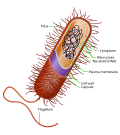Prokaryote
Prokaryote
A Prokaryote is a type of cell that does not have a nucleus or any other membrane-bound organelles. This means that all the genetic material is freely floating in the cytoplasm. Prokaryotes are usually single-celled organisms and are classified into two domains: Bacteria and Archaea.
Characteristics[edit]
Prokaryotes are typically much smaller than eukaryotic cells. They have a variety of shapes, the most common of which are spherical (coccus), rod-shaped (bacillus), and spiral (spirillum). Some prokaryotes have flagella or pili for locomotion.
Genetics[edit]
Prokaryotes have a single, circular chromosome that is not contained within a nucleus. They also have plasmids, which are small, circular pieces of DNA that can be transferred between cells.
Reproduction[edit]
Prokaryotes reproduce asexually through a process called binary fission. Some prokaryotes can also exchange genetic material through a process called horizontal gene transfer.
Ecology[edit]
Prokaryotes are found in nearly every environment on Earth. They play many important roles in ecosystems, such as decomposing organic material and fixing nitrogen.
Classification[edit]
Prokaryotes are divided into two domains: Bacteria and Archaea. Bacteria are the most diverse and well-known group of prokaryotes. Archaea were originally classified as bacteria, but they are genetically and biochemically distinct.
Health and disease[edit]
While many prokaryotes are beneficial, some can cause diseases. These pathogenic prokaryotes are a major cause of human illness.
See also[edit]
Ad. Transform your life with W8MD's Budget GLP-1 injections from $49.99


W8MD offers a medical weight loss program to lose weight in Philadelphia. Our physician-supervised medical weight loss provides:
- Weight loss injections in NYC (generic and brand names):
- Zepbound / Mounjaro, Wegovy / Ozempic, Saxenda
- Most insurances accepted or discounted self-pay rates. We will obtain insurance prior authorizations if needed.
- Generic GLP1 weight loss injections from $49.99 for the starting dose of Semaglutide and $65.00 for Tirzepatide.
- Also offer prescription weight loss medications including Phentermine, Qsymia, Diethylpropion, Contrave etc.
NYC weight loss doctor appointmentsNYC weight loss doctor appointments
Start your NYC weight loss journey today at our NYC medical weight loss and Philadelphia medical weight loss clinics.
- Call 718-946-5500 to lose weight in NYC or for medical weight loss in Philadelphia 215-676-2334.
- Tags:NYC medical weight loss, Philadelphia lose weight Zepbound NYC, Budget GLP1 weight loss injections, Wegovy Philadelphia, Wegovy NYC, Philadelphia medical weight loss, Brookly weight loss and Wegovy NYC
|
WikiMD's Wellness Encyclopedia |
| Let Food Be Thy Medicine Medicine Thy Food - Hippocrates |
Medical Disclaimer: WikiMD is not a substitute for professional medical advice. The information on WikiMD is provided as an information resource only, may be incorrect, outdated or misleading, and is not to be used or relied on for any diagnostic or treatment purposes. Please consult your health care provider before making any healthcare decisions or for guidance about a specific medical condition. WikiMD expressly disclaims responsibility, and shall have no liability, for any damages, loss, injury, or liability whatsoever suffered as a result of your reliance on the information contained in this site. By visiting this site you agree to the foregoing terms and conditions, which may from time to time be changed or supplemented by WikiMD. If you do not agree to the foregoing terms and conditions, you should not enter or use this site. See full disclaimer.
Credits:Most images are courtesy of Wikimedia commons, and templates, categories Wikipedia, licensed under CC BY SA or similar.
Translate this page: - East Asian
中文,
日本,
한국어,
South Asian
हिन्दी,
தமிழ்,
తెలుగు,
Urdu,
ಕನ್ನಡ,
Southeast Asian
Indonesian,
Vietnamese,
Thai,
မြန်မာဘာသာ,
বাংলা
European
español,
Deutsch,
français,
Greek,
português do Brasil,
polski,
română,
русский,
Nederlands,
norsk,
svenska,
suomi,
Italian
Middle Eastern & African
عربى,
Turkish,
Persian,
Hebrew,
Afrikaans,
isiZulu,
Kiswahili,
Other
Bulgarian,
Hungarian,
Czech,
Swedish,
മലയാളം,
मराठी,
ਪੰਜਾਬੀ,
ગુજરાતી,
Portuguese,
Ukrainian








